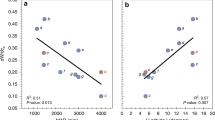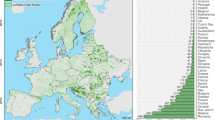Abstract
Terrestrial plants remove CO2 from the atmosphere through photosynthesis, a process that is accompanied by the loss of water vapour from leaves1. The ratio of water loss to carbon gain, or water-use efficiency, is a key characteristic of ecosystem function that is central to the global cycles of water, energy and carbon2. Here we analyse direct, long-term measurements of whole-ecosystem carbon and water exchange3. We find a substantial increase in water-use efficiency in temperate and boreal forests of the Northern Hemisphere over the past two decades. We systematically assess various competing hypotheses to explain this trend, and find that the observed increase is most consistent with a strong CO2 fertilization effect. The results suggest a partial closure of stomata1—small pores on the leaf surface that regulate gas exchange—to maintain a near-constant concentration of CO2 inside the leaf even under continually increasing atmospheric CO2 levels. The observed increase in forest water-use efficiency is larger than that predicted by existing theory and 13 terrestrial biosphere models. The increase is associated with trends of increasing ecosystem-level photosynthesis and net carbon uptake, and decreasing evapotranspiration. Our findings suggest a shift in the carbon- and water-based economics of terrestrial vegetation, which may require a reassessment of the role of stomatal control in regulating interactions between forests and climate change, and a re-evaluation of coupled vegetation–climate models.
This is a preview of subscription content, access via your institution
Access options
Subscribe to this journal
Receive 51 print issues and online access
$199.00 per year
only $3.90 per issue
Buy this article
- Purchase on Springer Link
- Instant access to full article PDF
Prices may be subject to local taxes which are calculated during checkout



Similar content being viewed by others
References
Berry, J. A., Beerling, D. J. & Franks, P. J. Stomata: key players in the earth system, past and present. Curr. Opin. Plant Biol. 13, 232–239 (2010)
Beer, C. et al. Temporal and among-site variability of inherent water use efficiency at the ecosystem level. Glob. Biogeochem. Cycles 23, 1–13 (2009)
Baldocchi, D. Breathing of the terrestrial biosphere: lessons learned from a global network of carbon dioxide flux measurement systems. Aust. J. Bot. 56, 1–26 (2008)
Field, C. B., Jackson, R. B. & Mooney, H. A. Stomatal responses to increased CO2: implications from the plant to the global scale. Plant Cell Environ. 18, 1214–1225 (1995)
Katul, G. G., Palmroth, S. & Oren, R. Leaf stomatal responses to vapour pressure deficit under current and CO2-enriched atmosphere explained by the economics of gas exchange. Plant Cell Environ. 32, 968–979 (2009)
Lewis, S. L. et al. Increasing carbon storage in intact African tropical forests. Nature 457, 1003–1006 (2009)
Salzer, M. W., Hughes, M. K., Bunn, A. G. & Kipfmueller, K. F. Recent unprecedented tree-ring growth in bristlecone pine at the highest elevations and possible causes. Proc. Natl Acad. Sci. USA 106, 20348–20353 (2009)
McMahon, S. M., Parker, G. G. & Miller, D. R. Evidence for a recent increase in forest growth. Proc. Natl Acad. Sci. USA 107, 3611–3615 (2010)
Ballantyne, A. P., Alden, C. B., Miller, J. B., Tans, P. P. & White, J. W. C. Increase in observed net carbon dioxide uptake by land and oceans during the past 50 years. Nature 488, 70–72 (2012)
Norby, R. J. & Zak, D. R. Ecological lessons from free-air CO2 enrichment (FACE) experiments. Annu. Rev. Ecol. Evol. Syst. 42, 181–203 (2011)
Peñuelas, J., Canadell, J. G. & Ogaya, R. Increased water-use efficiency during the 20th century did not translate into enhanced tree growth. Glob. Ecol. Biogeogr. 20, 597–608 (2011)
Seibt, U., Rajabi, A., Griffiths, H. & Berry, J. A. Carbon isotopes and water use efficiency: sense and sensitivity. Oecologia 155, 441–454 (2008)
Schubert, B. A. & Jahren, A. H. The effect of atmospheric CO2 concentration on carbon isotope fractionation in C3 land plants. Geochim. Cosmochim. Acta 96, 29–43 (2012)
Ainsworth, E. A. & Rogers, A. The response of photosynthesis and stomatal conductance to rising [CO2]: mechanisms and environmental interactions. Plant Cell Environ. 30, 258–270 (2007)
Saurer, M., Siegwolf, R. T. W. & Schweingruber, F. H. Carbon isotope discrimination indicates improving water-use efficiency of trees in northern Eurasia over the last 100 years. Glob. Change Biol. 10, 2109–2120 (2004)
Battipaglia, G. et al. Elevated CO2 increases tree-level intrinsic water use efficiency: insights from carbon and oxygen isotope analyses in tree rings across three forest FACE sites. New Phytol. 197, 544–554 (2013)
Drake, J. E. et al. Increases in the flux of carbon belowground stimulate nitrogen uptake and sustain the long-term enhancement of forest productivity under elevated CO2 . Ecol. Lett. 14, 349–357 (2011)
Schmidt, A., Hanson, C., Chan, W. S. & Law, B. E. Empirical assessment of uncertainties of meteorological parameters and turbulent fluxes in the AmeriFlux network. J. Geophys. Res. 117, G04014 (2012)
Medlyn, B. E. et al. Reconciling the optimal and empirical approaches to modelling stomatal conductance. Glob. Change Biol. 17, 2134–2144 (2011)
Buckley, T. N. The role of stomatal acclimation in modelling tree adaptation to high CO2 . J. Exp. Bot. 59, 1951–1961 (2008)
Jones, J. A. et al. Ecosystem processes and human influences regulate streamflow response to climate change at long-term ecological research sites. Bioscience 62, 390–404 (2012)
Dragoni, D. et al. Evidence of increased net ecosystem productivity associated with a longer vegetated season in a deciduous forest in south-central Indiana, USA. Glob. Change Biol. 17, 886–897 (2011)
Niinemets, U., Flexas, J. & Peñuelas, J. Evergreens favored by higher responsiveness to increased CO2 . Trends Ecol. Evol. 26, 136–142 (2011)
Bernacchi, C. J., Kimball, B. A., Quarles, D. R., Long, S. P. & Ort, D. R. Decreases in stomatal conductance of soybean under open-air elevation of [CO2] are closely coupled with decreases in ecosystem evapotranspiration. Plant Physiol. 143, 134–144 (2007)
Lee, X. et al. Observed increase in local cooling effect of deforestation at higher latitudes. Nature 479, 384–387 (2011)
Betts, R. A. et al. Projected increase in continental runoff due to plant responses to increasing carbon dioxide. Nature 448, 1037–1041 (2007)
Keys, P. W. et al. Analyzing precipitationsheds to understand the vulnerability of rainfall dependent regions. Biogeosciences 9, 733–746 (2012)
Nemani, R. R. et al. Climate-driven increases in global terrestrial net primary production from 1982 to 1999. Science 300, 1560–1563 (2003)
Reichstein, M. et al. On the separation of net ecosystem exchange into assimilation and ecosystem respiration: review and improved algorithm. Glob. Change Biol. 11, 1424–1439 (2005)
Desai, A. R. et al. Cross-site evaluation of eddy covariance GPP and RE decomposition techniques. Agric. For. Meteorol. 148, 821–838 (2008)
Papale, D. et al. Towards a standardized processing of net ecosystem exchange measured with eddy covariance technique: algorithms and uncertainty estimation. Biogeosciences 3, 571–583 (2006)
Khairi, M. M. A. & Hall, A. E. Comparative studies of net photosynthesis and transpiration of some citrus species and relatives. Physiol. Plant. 36, 35–39 (1976)
Grelle, A., Lundberg, A., Lindroth, A., Morén, A.-S. & Cienciala, E. Evaporation components of a boreal forest: variations during the growing season. J. Hydrol. 197, 70–87 (1997)
Acknowledgements
This research was supported by the NOAA Climate Program Office, Global Carbon Cycle Program (award NA11OAR4310054) and the Office of Science (Biological and Environmental Research), US Department of Energy. G.B. acknowledges a grant from the National Science Foundation (grant number DEB-0911461). This work used eddy covariance data acquired by the FLUXNET community and in particular by the AmeriFlux, CarboEuropeIP and Fluxnet-Canada networks. AmeriFlux was supported by the US Department of Energy, Biological and Environmental Research, Terrestrial Carbon Program (grant numbers DE-FG02-04ER63917 and DE-FG02-04ER63911, DE-SC0006708) and Fluxnet-Canada was supported by CFCAS, NSERC, BIOCAP, Environment Canada and NRCan. We acknowledge financial support of the eddy covariance data harmonization provided by CarboEuropeIP, FAO-GTOS-TCO, iLEAPS, the Max-Planck Institute for Biogeochemistry, National Science Foundation, University of Tuscia, Université Laval and Environment Canada and US Department of Energy and of the database development and technical support from Berkeley Water Center, Lawrence Berkeley National Laboratory, Microsoft Research eScience, Oak Ridge National Laboratory, University of California-Berkeley, University of Virginia. We thank all those involved in the NACP Site Synthesis, in particular the modelling teams who provided model output. Research at the Bartlett Experimental Forest tower is supported by the National Science Foundation (grant DEB-1114804), and the USDA Forest Service’s Northern Research Station. Research at Howland Forest is supported by the Office of Science (BER), US Department of Energy. Carbon flux and biometric measurements at Harvard Forest have been supported by the Office of Science (BER), US Department of Energy and the National Science Foundation Long-Term Ecological Research programmes. We thank S. Ollinger and S. Frey for maintaining the long-term leaf nitrogen measurements at Harvard Forest, and B. Yang for providing gap-filled meteorological data for the regional focus sites.
Author information
Authors and Affiliations
Contributions
T.F.K. and A.D.R. designed the study and are responsible for the integrity of the manuscript. A.D.R. planned the regional analysis, with input from D.Y.H., J.W.M., G.B., H.P.S. and D.D. A.D.R., D.Y.H., J.W.M., G.B., H.P.S. and D.D. contributed data. T.F.K. compiled the data sets, detailed and performed the analysis. A.D.R. and D.Y.H. contributed ideas to the analysis. T.F.K. led the writing, with input from A.D.R. and D.Y.H. All authors discussed and commented on the results and the manuscript.
Corresponding authors
Ethics declarations
Competing interests
The authors declare no competing financial interests.
Supplementary information
Supplementary Information
This file contains Supplementary Text and Data, Supplementary Figures 1-30, Supplementary Tables 1-3 and Supplementary References. (PDF 3816 kb)
Rights and permissions
About this article
Cite this article
Keenan, T., Hollinger, D., Bohrer, G. et al. Increase in forest water-use efficiency as atmospheric carbon dioxide concentrations rise. Nature 499, 324–327 (2013). https://doi.org/10.1038/nature12291
Received:
Accepted:
Published:
Issue Date:
DOI: https://doi.org/10.1038/nature12291
This article is cited by
-
More than 17,000 tree species are at risk from rapid global change
Nature Communications (2024)
-
Enhanced future vegetation growth with elevated carbon dioxide concentrations could increase fire activity
Communications Earth & Environment (2024)
-
Temporal dynamics of ecosystem, inherent, and underlying water use efficiencies of forests, grasslands, and croplands and their responses to climate change
Carbon Balance and Management (2023)
-
Increased risk of flash droughts with raised concurrent hot and dry extremes under global warming
npj Climate and Atmospheric Science (2023)
-
Evidence and attribution of the enhanced land carbon sink
Nature Reviews Earth & Environment (2023)
Comments
By submitting a comment you agree to abide by our Terms and Community Guidelines. If you find something abusive or that does not comply with our terms or guidelines please flag it as inappropriate.



